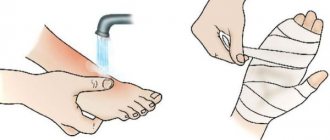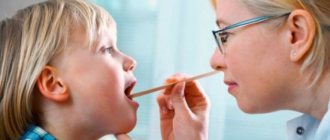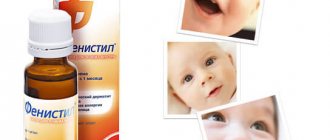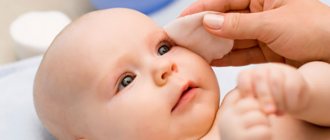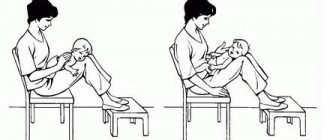General rules
Acute abdominal pain is associated with acute processes - acute appendicitis , pancreatitis , cholecystitis or mesadenitis - inflammation of the lymph nodes of the intestinal mesentery.
Despite the relatively common occurrence of mesadenitis in children, it is a poorly studied disease. Interest in it is caused by the fact that clinical manifestations mask acute appendicitis, there are diagnostic difficulties and diagnostic errors are possible. It is known that acute non-specific mesadenitis in children under 10 years of age is more common than appendicitis. The peak incidence coincides with the height of the incidence of ARVI. Infectious agents (bacteria or viruses) can enter the lymph nodes from the intestines, through the blood or lymph flow. Mesadenitis is more common at the age of 5-13 years and is often secondary - after suffering from acute respiratory viral infection or tonsillitis on the eve. Boys get sick more often than girls.
The main pathogens causing the disease are:
- adenoviruses and enteroviruses ;
- Epstein-Barr virus;
- cytomegalovirus;
- coli;
- streptococci;
- salmonella;
- Mycobacterium tuberculosis ;
- Yersinia;
- beta-hemolytic staphylococcus.
The clinical picture is dominated by abdominal pain (in the navel or on the right) of varying intensity. They are often paroxysmal in nature. The temperature rises to 38, nausea appears, less often vomiting, pasty stools and bloating. The general condition is usually satisfactory, but significantly worsens in the presence of purulent mesadenitis.
Mesadenitis in children, treatment and diet
Treatment of mesadenitis is conservative: the child is prescribed rest, antibacterial (for 5-7 days) and antiviral therapy, antihistamines and antispasmodics, physiotherapeutic procedures (repeated courses of UHF, paraffin baths, ultraviolet radiation). Successful treatment is facilitated by the elimination of foci of infection (carious teeth, chronic tonsillitis ). As necessary, complex conservative treatment of mesadenitis is repeated. If the course is mild, no treatment is carried out, but if it is purulent, surgery is indicated.
In severe cases of the disease in weakened children and lack of treatment, complications in the form of peritoneal abscess, peritonitis , adhesive disease or intestinal obstruction .
In all cases, treatment of mesadenitis in children with diet is indicated. All patients are recommended to follow a diet ( Table No. 5 ), which provides:
- fractional meals;
- sparing the gastrointestinal tract, which is achieved by avoiding fried, fatty, spicy and smoked foods;
- preparing dishes by boiling, stewing or baking;
- limitation of refractory animal fats;
- limiting simple carbohydrates (candies, sweets, jam, confectionery), baked goods and baked goods in the diet;
- exclusion of coarse foods that stimulate intestinal motility (legumes, radishes, white cabbage, radishes, mushrooms, an abundance of fresh vegetables).
If there is constipation, boiled grated vegetables with vegetable oil (beets, carrots, pumpkin), steamed prunes, dried apricots and figs are introduced into the diet.
Treatment
Photo: ru-babyhealth.ru
Treatment of mesadenitis begins with adherence to the regimen. In the acute period of the disease, strict bed rest is prescribed; in the chronic course, a general regime is prescribed, but with limited physical activity.
Much attention is paid to nutrition. It is necessary to avoid fatty, fried, smoked, highly salted foods, flour products, coffee, strong tea, and alcohol. Preference should be given to low-fat varieties of meat and fish, cereals, vegetable soups, dried fruit compotes, and fruit drinks. Food is taken in small portions 4-5 times a day. Drinking plenty of fluids to remove toxins from the body and quitting smoking are also recommended.
To directly influence the source of infection, antibacterial drugs (antibiotics) are prescribed. The choice of drug depends on the type of pathogen.
To eliminate pain and intoxication syndromes, antispasmodics, anti-inflammatory and analgesic drugs are prescribed. For intense pain that does not go away under the influence of painkillers, a perirenal block is performed (injection of an anesthetic into the perinephric space). It is rarely performed, as the necessary skills are required and there is a risk of complications.
For purulent mesadenitis, only surgical treatment is indicated. The abscess is opened and drained, followed by an inspection of the abdominal cavity.
Physiotherapeutic treatment is prescribed as an auxiliary therapy: UHF therapy, magnetic therapy.
Authorized Products
The diet for mesadenitis in children includes:
- Low-fat meat and fish dishes that can be prepared from beef, veal, rabbit, chicken, turkey, cod, pike, whiting, pike perch, pollock, navaga, hake. The choice of dishes is varied and depends entirely on your child's preferences. It can be simply boiled meat or fish, cutlets, meatballs, meatballs, pates, soufflés. Remember that they all must be steamed or oven-cooked.
- Vegetarian soups (with vegetable broth or water). Usually these are a variety of cereal soups or with soft pasta, since children are reluctant to eat vegetable soups. During illness, avoid eating okroshka, neck with sauerkraut, and borscht (due to the presence of cabbage and tomato dressing). It is not allowed to fry vegetables to season soups. Milk soups are also recommended.
- Dried wheat bread, since fresh, and especially warm, recently baked bread, causes excessive intestinal bloating and discomfort, which should be avoided with this disease. You can offer your child unsweetened crackers, crackers, not very sweet dried biscuits and biscuits. Sweet croutons, especially those with raisins, are not advisable, as they can also increase bloating.
- Steamed omelettes and soft-boiled eggs (hard-boiled eggs are difficult to digest).
- Low-fat dairy products. It is better to give preference to fermented milk drinks, taking into account the existing loosening of the stool. In case of inflammatory processes in the abdominal cavity, whole milk can cause bloating and discomfort. If the child is well tolerated and has no stool disorders, you can prepare porridge with water for your child, but with the addition of milk. It is recommended to use low-fat cottage cheese in its natural form with dried fruits. If your child does not eat cottage cheese in its natural form, try making cottage cheese souffles and casseroles with a small amount of semolina. You can add slices of peeled apple and pumpkin to casseroles. Curd dishes are served with a small amount of low-fat sour cream.
- Butter (vegetable) oil in the amount of 0.5 tsp. Add to a portion of porridge or vegetable puree.
- Buckwheat, rice, and oatmeal are considered porridges with coarse fiber, so they will be most suitable during illness.
- Baked, boiled and stewed vegetables irritate the mucous membrane and stimulate intestinal motility to a lesser extent than raw ones, therefore they are most acceptable for this disease. In addition, processed fiber does not cause flatulence to the same extent as raw fiber. Initially, it is worth excluding coarse and irritating vegetables (radish, radish, mushrooms, parsnips, celery, garlic). Dishes can be seasoned with a small amount of dried dill and parsley.
- Eating homemade sauces based on low-fat milk and sour cream. They can be used when baking fish, cutlets and meatballs.
- It is better to consume fruits and berries in the form of purees, compotes and jelly, since fresh ones can cause increased pain.
- For sweets, a small amount of honey and homemade jam is allowed.
- During the day, the child can drink a decoction of rosehip, sea buckthorn, rowan, viburnum, weak tea, chamomile and sage tea, freshly squeezed vegetable and fruit juices.
Table of permitted products
| Proteins, g | Fats, g | Carbohydrates, g | Calories, kcal | |
Vegetables and greens | ||||
| eggplant | 1,2 | 0,1 | 4,5 | 24 |
| zucchini | 0,6 | 0,3 | 4,6 | 24 |
| cabbage | 1,8 | 0,1 | 4,7 | 27 |
| broccoli | 3,0 | 0,4 | 5,2 | 28 |
| carrot | 1,3 | 0,1 | 6,9 | 32 |
| cucumbers | 0,8 | 0,1 | 2,8 | 15 |
| parsley | 3,7 | 0,4 | 7,6 | 47 |
| tomatoes | 0,6 | 0,2 | 4,2 | 20 |
| pumpkin | 1,3 | 0,3 | 7,7 | 28 |
| dill | 2,5 | 0,5 | 6,3 | 38 |
Fruits | ||||
| bananas | 1,5 | 0,2 | 21,8 | 95 |
| apples | 0,4 | 0,4 | 9,8 | 47 |
Nuts and dried fruits | ||||
| raisin | 2,9 | 0,6 | 66,0 | 264 |
| dried figs | 3,1 | 0,8 | 57,9 | 257 |
| dried apricots | 5,2 | 0,3 | 51,0 | 215 |
| dried apricots | 5,0 | 0,4 | 50,6 | 213 |
| prunes | 2,3 | 0,7 | 57,5 | 231 |
Cereals and porridges | ||||
| buckwheat (kernel) | 12,6 | 3,3 | 62,1 | 313 |
| oat groats | 12,3 | 6,1 | 59,5 | 342 |
| rice | 6,7 | 0,7 | 78,9 | 344 |
Flour and pasta | ||||
| pasta | 10,4 | 1,1 | 69,7 | 337 |
| noodles | 12,0 | 3,7 | 60,1 | 322 |
| buckwheat noodles | 14,7 | 0,9 | 70,5 | 348 |
Bakery products | ||||
| wheat bread | 8,1 | 1,0 | 48,8 | 242 |
Confectionery | ||||
| jelly | 2,7 | 0,0 | 17,9 | 79 |
| Maria cookies | 8,7 | 8,8 | 70,9 | 400 |
Raw materials and seasonings | ||||
| honey | 0,8 | 0,0 | 81,5 | 329 |
| sugar | 0,0 | 0,0 | 99,7 | 398 |
Dairy | ||||
| kefir 1.5% | 3,3 | 1,5 | 3,6 | 41 |
| Ryazhenka | 2,8 | 4,0 | 4,2 | 67 |
Cheeses and cottage cheese | ||||
| cottage cheese 1% | 16,3 | 1,0 | 1,3 | 79 |
Meat products | ||||
| beef | 18,9 | 19,4 | 0,0 | 187 |
| rabbit | 21,0 | 8,0 | 0,0 | 156 |
Bird | ||||
| boiled chicken breast | 29,8 | 1,8 | 0,5 | 137 |
| boiled chicken drumstick | 27,0 | 5,6 | 0,0 | 158 |
| boiled turkey fillet | 25,0 | 1,0 | — | 130 |
Eggs | ||||
| soft-boiled chicken eggs | 12,8 | 11,6 | 0,8 | 159 |
Fish and seafood | ||||
| flounder | 16,5 | 1,8 | 0,0 | 83 |
| pollock | 15,9 | 0,9 | 0,0 | 72 |
| cod | 17,7 | 0,7 | — | 78 |
| hake | 16,6 | 2,2 | 0,0 | 86 |
Oils and fats | ||||
| butter | 0,5 | 82,5 | 0,8 | 748 |
| olive oil | 0,0 | 99,8 | 0,0 | 898 |
| sunflower oil | 0,0 | 99,9 | 0,0 | 899 |
Non-alcoholic drinks | ||||
| water | 0,0 | 0,0 | 0,0 | — |
| mineral water | 0,0 | 0,0 | 0,0 | — |
| green tea | 0,0 | 0,0 | 0,0 | — |
Juices and compotes | ||||
| apricot juice | 0,9 | 0,1 | 9,0 | 38 |
| carrot juice | 1,1 | 0,1 | 6,4 | 28 |
| peach juice | 0,9 | 0,1 | 9,5 | 40 |
| plum juice | 0,8 | 0,0 | 9,6 | 39 |
| tomato juice | 1,1 | 0,2 | 3,8 | 21 |
| pumpkin juice | 0,0 | 0,0 | 9,0 | 38 |
| rose hip juice | 0,1 | 0,0 | 17,6 | 70 |
| * data is per 100 g of product | ||||
Tuberculous mesadenitis
According to medical statistics, enlarged lymph nodes in the peritoneum are more often observed in children aged 6-14 years. In view of this, the occurrence of such a condition due to infection with Koch bacilli (tuberculosis form) is diagnosed in rare cases. It occurs due to the fact that pathogenic bacilli from the lungs enter the lymph, and with it are carried into the lymph nodes of the peritoneum. In this case, the following signs of inflammation are observed:
- The child becomes indifferent to games and lethargic.
- Lost appetite.
- There is weight loss.
- I am worried about a cough that cannot be treated with classical methods.
- The skin becomes pale.
- The temperature stays between 37.1-37.3 degrees Celsius.
If the lymph nodes in the child’s abdominal cavity are enlarged precisely because of suspected tuberculosis, what should be done? First of all, you need to perform a test for the presence of Koch bacilli in the blood. It is better known as the Mantoux reaction.
Nowadays, you can catch tuberculosis anywhere - in transport, in child care institutions, during public events. At risk are children whose family members suffer from this disease, as well as those children who have undergone any disease or surgery after which their immunity has decreased. Parents of such children should immediately consult a doctor if the child develops the above symptoms.
Fully or partially limited products
Should be excluded:
- fatty meat, fish, smoked meat and fish, goose and duck meat, salted fish, sausages, any types of canned food;
- animal fats and lard;
- rich broths;
- any fried foods (pies, pancakes, meat, fish, pancakes);
- fresh bread, pastries made from puff pastry, shortbread and butter dough, pastries and pies;
- legumes, radishes, turnips, radishes, white cabbage, garlic, onions, sorrel;
- eggs, hard-boiled and fried;
- all dairy products;
- hot seasonings, ketchup, mayonnaise;
- coffee, chocolate and cocoa.
Table of prohibited products
| Proteins, g | Fats, g | Carbohydrates, g | Calories, kcal | |
Vegetables and greens | ||||
| canned vegetables | 1,5 | 0,2 | 5,5 | 30 |
| swede | 1,2 | 0,1 | 7,7 | 37 |
| peas | 6,0 | 0,0 | 9,0 | 60 |
| bulb onions | 1,4 | 0,0 | 10,4 | 41 |
| chickpeas | 19,0 | 6,0 | 61,0 | 364 |
| radish | 1,2 | 0,1 | 3,4 | 19 |
| white radish | 1,4 | 0,0 | 4,1 | 21 |
| beans | 7,8 | 0,5 | 21,5 | 123 |
| horseradish | 3,2 | 0,4 | 10,5 | 56 |
| spinach | 2,9 | 0,3 | 2,0 | 22 |
| sorrel | 1,5 | 0,3 | 2,9 | 19 |
Berries | ||||
| grape | 0,6 | 0,2 | 16,8 | 65 |
Mushrooms | ||||
| mushrooms | 3,5 | 2,0 | 2,5 | 30 |
| marinated mushrooms | 2,2 | 0,4 | 0,0 | 20 |
Nuts and dried fruits | ||||
| nuts | 15,0 | 40,0 | 20,0 | 500 |
| almond | 18,6 | 57,7 | 16,2 | 645 |
Snacks | ||||
| potato chips | 5,5 | 30,0 | 53,0 | 520 |
Cereals and porridges | ||||
| corn grits | 8,3 | 1,2 | 75,0 | 337 |
| pearl barley | 9,3 | 1,1 | 73,7 | 320 |
Flour and pasta | ||||
| vareniki | 7,6 | 2,3 | 18,7 | 155 |
| dumplings | 11,9 | 12,4 | 29,0 | 275 |
Bakery products | ||||
| buns | 7,9 | 9,4 | 55,5 | 339 |
| Rye bread | 6,6 | 1,2 | 34,2 | 165 |
Confectionery | ||||
| pastry cream | 0,2 | 26,0 | 16,5 | 300 |
| shortbread dough | 6,5 | 21,6 | 49,9 | 403 |
Ice cream | ||||
| ice cream | 3,7 | 6,9 | 22,1 | 189 |
Chocolate | ||||
| chocolate | 5,4 | 35,3 | 56,5 | 544 |
Raw materials and seasonings | ||||
| mustard | 5,7 | 6,4 | 22,0 | 162 |
| mayonnaise | 2,4 | 67,0 | 3,9 | 627 |
Dairy | ||||
| milk 4.5% | 3,1 | 4,5 | 4,7 | 72 |
| cream 35% (fat) | 2,5 | 35,0 | 3,0 | 337 |
| whipped cream | 3,2 | 22,2 | 12,5 | 257 |
Cheeses and cottage cheese | ||||
| parmesan cheese | 33,0 | 28,0 | 0,0 | 392 |
Meat products | ||||
| fatty pork | 11,4 | 49,3 | 0,0 | 489 |
| salo | 2,4 | 89,0 | 0,0 | 797 |
| bacon | 23,0 | 45,0 | 0,0 | 500 |
Sausages | ||||
| smoked sausage | 9,9 | 63,2 | 0,3 | 608 |
Bird | ||||
| smoked chicken | 27,5 | 8,2 | 0,0 | 184 |
| duck | 16,5 | 61,2 | 0,0 | 346 |
| smoked duck | 19,0 | 28,4 | 0,0 | 337 |
| goose | 16,1 | 33,3 | 0,0 | 364 |
Fish and seafood | ||||
| smoked fish | 26,8 | 9,9 | 0,0 | 196 |
| black caviar | 28,0 | 9,7 | 0,0 | 203 |
| salmon caviar granular | 32,0 | 15,0 | 0,0 | 263 |
| salmon | 19,8 | 6,3 | 0,0 | 142 |
| canned fish | 17,5 | 2,0 | 0,0 | 88 |
| salmon | 21,6 | 6,0 | — | 140 |
| trout | 19,2 | 2,1 | — | 97 |
Oils and fats | ||||
| animal fat | 0,0 | 99,7 | 0,0 | 897 |
| cooking fat | 0,0 | 99,7 | 0,0 | 897 |
Non-alcoholic drinks | ||||
| soda water | 0,0 | 0,0 | 0,0 | — |
| cola | 0,0 | 0,0 | 10,4 | 42 |
| instant coffee dry | 15,0 | 3,5 | 0,0 | 94 |
| sprite | 0,1 | 0,0 | 7,0 | 29 |
| * data is per 100 g of product | ||||
Material and methods
A retrospective analysis of the medical records of 97 HIV-infected patients who were treated in the tuberculosis surgical department of the State Budgetary Healthcare Institution "MNPC for the fight against tuberculosis of the Department of Health" in 2012-2018 was carried out: 71 (73.2%) men and 26 (26.8%) women. The age of the patients ranged from 20 to 52 years, with an average of 33.9±7.9 years. All patients were diagnosed with HIV infection at stages 4B, 4B. Indications for hospitalization were symptoms of acute abdominal surgical pathology or the need to clarify identified pathological changes in a planned manner. Enlargement of the lymph nodes of the abdominal cavity and retroperitoneal space was determined in all patients included in the study. A comprehensive diagnostic examination was carried out, which included radiation methods (CT of the chest, ultrasound of the abdominal organs, CT of the abdominal organs with oral and intravenous contrast), laboratory tests of blood and urine, immune status, examination of sputum, urine, feces and biopsy samples lymph nodes for the detection of Mycobacterium tuberculosis (MBT) using fluorescent microscopy, polymerase chain reaction (PCR), cytological, histological and immunohistochemical studies of surgical material. Statistical processing of the research results was carried out using standard statistical methods and the Statgraphics software package.
Menu (Power Mode)
In any case, a child’s diet should be appropriate for his age and contain the required amount of protein, complex carbohydrates and vitamins. With this disease, food should be gentle and easily digestible. This includes protein from dairy products, fish and egg dishes. During treatment, the fat content is reduced by eliminating fatty foods and frying foods. Portions should be small - it is better to have snacks more often and not burden the provoked intestines.
| Breakfast |
|
| Lunch |
|
| Dinner |
|
| Afternoon snack |
|
| Dinner |
|
| For the night |
|
| Breakfast |
|
| Lunch |
|
| Dinner |
|
| Afternoon snack |
|
| Dinner |
|
| For the night |
|
| Breakfast |
|
| Lunch |
|
| Dinner |
|
| Afternoon snack |
|
| Dinner |
|
| For the night |
|
| Breakfast |
|
| Lunch |
|
| Dinner |
|
| Afternoon snack |
|
| Dinner |
|
| For the night |
|
Diet
In case of mesadenitis, special attention should be paid to the patient’s diet. The fifth table is recommended for patients. Such a therapeutic diet allows the consumption of crumbly cereals, non-acidic fruits, salads, legumes and lean beef, vegetable soups and chicken, white bread and low-fat cottage cheese, compote or tea.
Meals should be fractional, frequent, small portions. Spices and coffee, fatty fish and lard, fried meat, fresh baked goods, sorrel and semi-finished products, mustard and spinach are prohibited.
Reviews and results
Reviews from parents indicate the need for proper nutrition in this disease. In mild cases, no treatment was prescribed, and dietary intake was recommended to relieve inflammation and pain. Sparing the digestive organs and adhering to the principle of fractional nutrition gave positive results. First of all, nausea and abdominal discomfort decreased, stool normalized, and bloating significantly decreased. In general, the food does not differ from the healthy diet that a child is accustomed to. The only difference was the exclusion of unhealthy foods containing simple carbohydrates.
- “... My son’s acute respiratory viral infections and tonsillitis are always complicated by this disease. The abdomen becomes hard, bloated, spasms and pain bother you, and it all ends with vomiting. Often all this happens against the background of high temperature. This condition may last for a day or two. After this, weakness and poor appetite bother me. The first time we consulted a surgeon, and he made this diagnosis. We were tested for the Epstein Bar virus (not detected) and treated with antibiotics. Now we already know what it is, and if it’s not severe, then we don’t go anywhere. They said that we need to strengthen our immune system and prevent colds. But it’s difficult, since I just started kindergarten. As for the diet, I prepare everything for him in accordance with his age and do not allow sausages, preservatives, smoked foods, a lot of sweets, fatty and fried foods”;
- “... My daughter suffered from ARVI, and after 10 days abdominal pain appeared, again the temperature lasted for 2 days, and she felt a little better. We contacted a surgeon, took tests, and sent him for an ultrasound, where they discovered mesodenitis. 4 mesenteric lymph nodes are enlarged. The condition is not serious and the tests are almost normal, so no treatment was prescribed. Indeed, everything went away without treatment, only the condition was corrected with nutrition to reduce pain and inflammation in the abdomen. They recommended a gentle diet (Diet No. 5) - nothing fatty or fried, spicy, sausage or smoked. Over the weekend I kept her on soups, boiled meat, porridge, cottage cheese, and then went to kindergarten - the food there is also dietary. It’s good that now an ultrasound can make this diagnosis, otherwise we would have gone for surgery with suspected appendicitis”;
- “... A year ago I fell ill with bronchitis, after which my stomach began to hurt. They did an ultrasound of the abdominal cavity - single lymph nodes up to 16 mm. We were treated with antibiotics and physical therapy. procedures, followed the diet for almost 4 months, and everything returned to normal. However, against the background of a cold, the stomach hurts again and the nodes increase. I’m very worried, but I won’t give antibiotics. We switched to restoratives and Imunoflazid. The food is organized as it should be: porridge with water and milk, cottage cheese and dishes made from it (it helps that he eats it well), boiled meat, I steam cutlets in the oven. Drinks a lot of juices, infusions of rose hips, sea buckthorn and viburnum. Eats fruits and berries in season. We hope that with age he will get stronger and everything will return to normal.”
Folk remedies
Photo: wallpaperscraft.com
With such a disease, you should not hope that it will be possible to cope with it at home. Qualified medical assistance and immediate prescription of the necessary treatment are required. However, you can help your body fight the disease. You should start by following the regime. During the period of exacerbation, it is strictly bed rest; in the chronic course, you need to refrain from intense physical activity and lifting weights. It is also necessary to switch to a gentle diet. Meals should be fractional, at least 4 times a day. Dishes should be prepared in crushed or pureed form. During an exacerbation, special attention is paid to drinking plenty of fluids. This is necessary to remove toxins from the body, as a result, the symptoms of intoxication are reduced.
Infusions and decoctions of herbs will provide good help. The greatest effect for this disease is a decoction of blackberry root. The beneficial properties of blackberries have been known since ancient times. It has antipyretic, tonic, anti-inflammatory and bactericidal effects, which significantly helps in the treatment of mesadenitis.
As you know, decoctions and infusions with chamomile and calendula have analgesic and anti-inflammatory effects, which will help reduce pain and have a beneficial effect on the course of the disease.
A decoction of cumin will help normalize intestinal function. Both a decoction and an infusion of caraway seeds are used. In children under 7 years of age and in the acute stage of the disease in adults, preference is given to a decoction; in other cases, an infusion of seeds can be used.
It should be remembered that the listed options for folk remedies only help in alleviating symptoms, but for a complete recovery you should consult a doctor and strictly follow his recommendations.
The information is for reference only and is not a guide to action. Do not self-medicate. At the first symptoms of the disease, consult a doctor.
